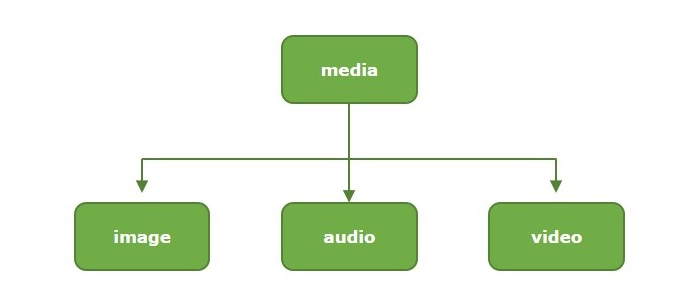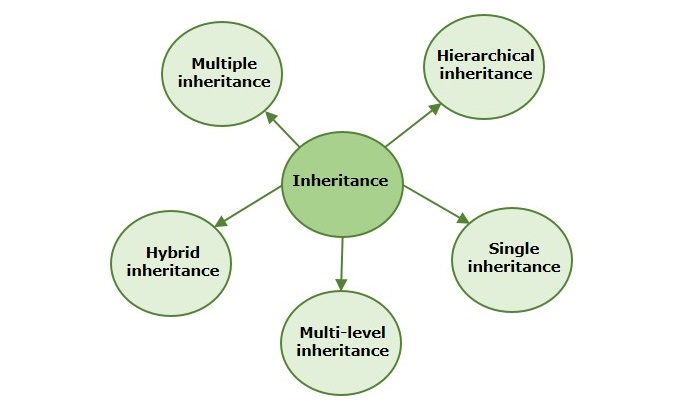什么是 Python 中的继承?
继承是 Python 等面向对象编程语言最重要的特性之一。它用于将一个类的属性和行为继承给另一个类。继承另一个类的类称为子类,被继承的类称为基类或父类。
如果你必须设计一个新类,其大多数属性已经在现有类中明确定义,那么为什么要重新定义它们呢?继承允许重用现有类的功能,并在需要时扩展以设计新类。
当新类与现有类具有 'IS A' 关系时,继承就会出现。例如,Car IS 车辆,Bus IS 车辆,Bike IS 车辆。此处,Vehicle 是父类,而 car、bus 和 bike 是子类。

创建 Parent Class
继承其属性和方法的类称为父类。它的定义与其他类一样,即使用 class 关键字。
语法
创建父类的语法如下所示 -
创建 Child 类
从基类继承的类的声明与其父类类似,但是,我们需要在括号内提供父类的名称。
语法
以下是子类的语法 -
继承的类型
在 Python 中,继承可以分为五个不同的类别 -
- 单一继承
- 多重继承
- 多级继承
- 分层继承
- 混合继承

Python - 单一继承
这是最简单的继承形式,其中子类仅从一个父类继承属性和方法。
例下面的示例显示了 Python 中的单一继承概念 -
在运行上述代码时,它将打印以下结果 -
Calling parent method
Python - 多重继承
Python 中的多重继承允许您基于多个父类构造一个类。因此,Child 类从所有父类继承属性和方法。子级可以覆盖从任何父级继承的方法。
语法
例
Python 的标准库有一个内置的 divmod() 函数,该函数返回一个包含两项的元组。第一个数字是两个参数的除法,第二个是两个操作数的 mod 值。
此示例尝试模拟 divmod() 函数。我们定义了两个类 division 和 modulus,然后有一个继承它们的 div_mod 类。
子类有一个新方法 div_and_mod(),它在内部从其继承的类中调用 divide() 和 mod_divide() 方法以返回 division 和 mod 值。
输出
mod_division: 1
divmod: (3.3333333333333335, 1)
方法解析顺序 (MRO)
术语 method resolution order 与 Python 中的多重继承有关。在 Python 中,继承可能分布在多个级别上。假设 A 是 B 的父级,B 是 C 的父级。类 C 可以覆盖继承的方法,或者其对象可以按照其父类中的定义调用它。那么,Python 如何找到合适的方法来调用呢。
每个 Python 都有一个 mro() 方法,该方法返回 Python 用于解析要调用的方法的层次结构顺序。解析顺序是从继承顺序的底部到顶部。
在前面的示例中,div_mod 类继承了 division 和 modulus 类。因此,mro 方法返回顺序如下 -
Python - 多级继承
在多级继承中,一个类派生自另一个派生类。存在多个继承层。我们可以把它想象成一种祖父母-亲子-子的关系。
例在下面的示例中,我们将说明多级继承的工作原理。
当我们执行上述代码时,它会产生以下结果——
I am on Earth
I am in India
Python - 分层继承
这种类型的继承包含从单个基类继承的多个派生类。这类似于组织内的层次结构。
例以下示例说明了分层继承。在这里,我们定义了 Manager 类的两个子类。
在执行上述程序时,您将获得以下输出 -
I am Employee one
I am the Manager
I am Employee two
Python - 混合继承
两种或多种继承类型的组合称为混合继承。例如,它可以是单继承和多继承的混合。
例在此示例中,我们将单个继承和多个继承组合在一起,以形成类的混合继承。
在运行上述程序时,它将给出以下结果 -
I am the CEO
I am Employee two
super() 函数
在 Python 中,super() 函数允许你从子类中访问父类的方法和属性。
例在下面的示例中,我们创建一个父类并使用 super() 函数从子类访问其构造函数。
在执行时,上述程序将给出以下结果 -



